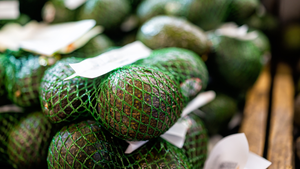A Cut AboveA Cut Above
Value-added meat and seafood products entice shoppers with the appeal of quick meals and adventurous chops and flavors.
A millennial walks into the grocery store…
It sounds like the start of a bad joke, but consider this: An inexperienced shopper is looking to buy a hearty protein for dinner. The meat case is filled with an assortment of fresh-looking items, but what do all the different cuts and styles mean? Chuck flap? Tenderloin? Brisket? Regardless of how unfamiliar the shopper may be with the meat category, one thing he or she will certainly recognize and trust is a brand name.
While the majority of fresh meat is not branded, but rather cut and packaged in the retailer’s back room or in case-ready packages under the retailer’s brand, one of the most influential aspects of branding in the supermarket industry is in the meat case.
According to FMI’s The Power of Meat 2017, consumers are more willing to try higher-quality, premium cuts of meats, and they’re more likely to stick to brand names, while worrying less about comparing prices on their path to purchase. First and foremost, delivering a consistent, high-quality product is key to driving sales and building brand loyalty across the entire meat category.
Adding Allure With Value
Value-added meats are gaining in popularity, according to The Power of Meat 2017, including items that are premarinated, precut or preseasoned. “These products will continue to grow as long as we can continue to add value in a quick meal replacement,” says David MacVane, VP of retail at Wooster, Ohio-based Certified Angus Beef (CAB). “The industry at one point almost went too far because we went from fresh meat to a totally cooked, whole meal replacement. I don’t know if that’s what [consumers were] really looking for.”
Instead, MacVane says shoppers are increasingly seeking fresh meat that’s marinated and properly portioned, which is why Certified Angus Beef keeps its portions to around 12 ounces and offers a variety of marinades. For instance, at its recent annual Beef Bash conference in Nashville, CAB showcased its slow-roasted, ready-to-cook Marinated Petite Filets, available in steakhouse, teriyaki and bourbon flavors.
Consumers are making this shift with their seafood purchases, too. Cermak Fresh Market, based in Chicago, has noticed a decline in fresh seafood items that require additional prep time, like stone crab claws, whole lobsters and whole shell-on fish. Sales of raw shell-on shrimp have dropped 87%, according to Jessy Rodriguez, Cermak’s meat and seafood director, but prepeeled shrimp sales have spiked 125%. “Trends have shifted toward more consumer-friendly items,” says Rodriguez, including marinated filets, salmon kebabs and homemade ceviche.
Cermak also offers free merchandising at the store level, where shoppers can purchase a whole fish to be descaled, steaked or filleted at no additional cost. Despite adding a dollar to the initial retail price to offset the extra labor costs, the 15-store retailer has seen a positive impact on gross dollars and overall volume. “We’re trying to eliminate as many prep steps for the consumer as possible, so that the one thing they have to do is just turn on their stove or grill and have a meal in the shortest amount of time possible,” says Rodriguez.
Although ready to cook, it’s important that value-added meat and seafood still gives consumers a sense of involvement and accomplishment in the meal-making process, rather than eliminating their role entirely. “We’re seeing a lot of opportunity for meal kits, whether they are preassembled and then sold by the supplier to the store, or whether the store is assembling them themselves,” says Brett Erickson, director of value-added products at CAB. Retailers can compete with the likes of HelloFresh and Amazon by building fresh meal kits in-house, where consumers can actually see the contents before making a purchase.
When it comes to fresh pork, consistency is key. “Consumers base pork purchases on quality as defined by color, packaging and expiration date, and they will purchase pork repeatedly if their eating experience is consistently positive,” says Stephen Gerike, assistant VP of channel marketing at the National Pork Board, based in Des Moines, Iowa. “Consistency appears to hold the strongest case for moving the demand needle forward.”
The National Pork Board’s Gerike recommends retailers promote specific cuts to help drive demand and add value to loin chops, in particular. “We want people to talk about a pork Porterhouse chop (formerly a bone-in pork loin) and relate it to a Porterhouse steak,” he says. “This reinforces that the cut is good for grilling and is tender and high-quality.”
Catering to Multicultural Needs
Perhaps the biggest draw to value-added meat and seafood is the appeal of a convenient meal solution. But it also offers adventurous shoppers an avenue for cultural exploration. According to A Fresh Look at Multicultural Consumers, a report by New York City-based research firm Nielsen, multicultural consumers are the fastest-growing segment of the U.S. population, and they spend more time in the meat and seafood departments than any other department. As such, retailers’ in-store strategies must include a wider range of fresh food products and flavor profiles that cater to these diverse multicultural needs.
“As we become a little bit more united and a little bit more global, then the foods that are we eating today like the cross-proteins of pork tacos and some of the other ethnic dishes continue to grow,” says CAB’s MacVane. “Now we’re looking at what cuts, what region, what climate, where they have to be, and what are the flavor profiles that those cultures are looking for.”
From Asian to Hispanic to Southern barbecue influences, the same cuts of meat and seafood can be preseasoned and premarinated to appeal to different tastes. The key is getting consumers to try the product. “I think the biggest thing that retailers can do is to sample,” says CAB’s Erickson. “You see some of the higher-end retailers doing a great job of getting the product to people’s mouths because people enjoy shopping. Those who want to go and experience the food, who are feeding their families, who are enjoying themselves, want to explore.”
Abingdon, Va.-based Food City not only samples its famous slow-smoked meats in-store, but it creates an entire event around it. The grocer brings the “Q” mobile smoker to different store locations each week—not just offering samples to a wider audience, but creating community excitement and a dedicated mobile smoker following via social media. This exposes shoppers to new flavors, recipes and cuts of meat, as well.
The Alaska Seafood Marketing Institute, based in Juneau, Alaska, also pushes promotion of diverse seafood varieties and flavors. In October, the company partnered with select retailers to promote fresh Alaska seafood for National Seafood Month. Whole Foods Market offered in-store cooking demos with chef-prepared sockeye, pairing sauteed salmon samples with wine for guests, while Hy-Vee and Schnuck Markets focused on Alaska pollock and cod, featuring demos, designated displays and targeted social ads.
About the Author
You May Also Like






